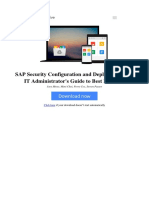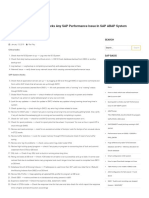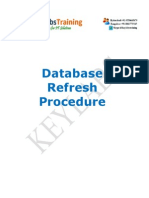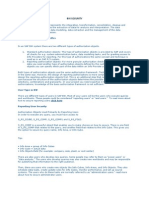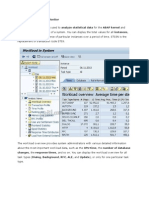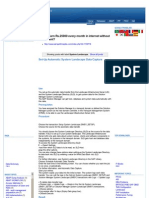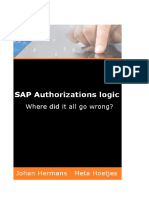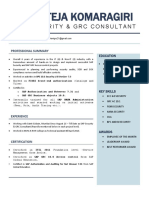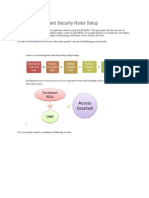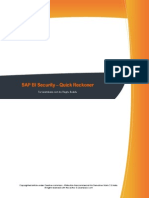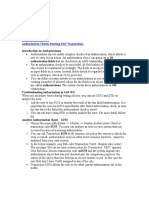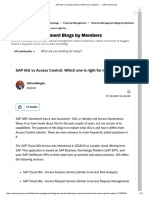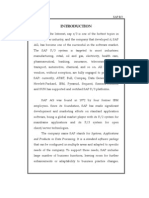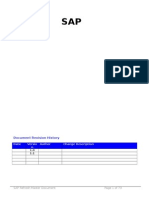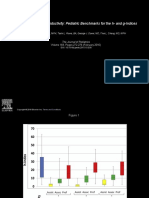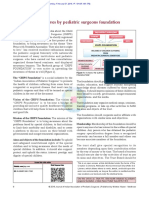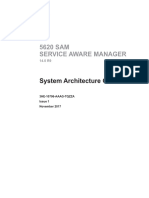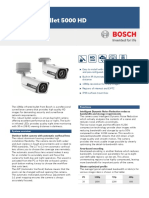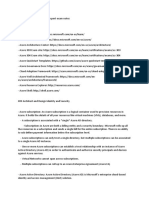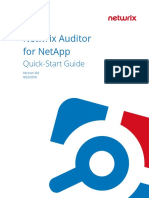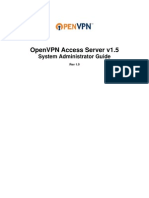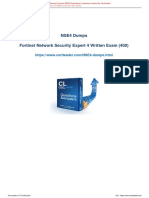0 ratings0% found this document useful (0 votes)
517 viewsSecurity in SAP HANA
Security in SAP HANA
Uploaded by
samy22722Security_In_SAP_HANASecurity_In_SAP_HANA
Copyright:
© All Rights Reserved
Available Formats
Download as PDF, TXT or read online from Scribd
Security in SAP HANA
Security in SAP HANA
Uploaded by
samy227220 ratings0% found this document useful (0 votes)
517 views15 pagesSecurity_In_SAP_HANASecurity_In_SAP_HANA
Original Title
Security_In_SAP_HANA----------------
Copyright
© © All Rights Reserved
Available Formats
PDF, TXT or read online from Scribd
Share this document
Did you find this document useful?
Is this content inappropriate?
Security_In_SAP_HANASecurity_In_SAP_HANA
Copyright:
© All Rights Reserved
Available Formats
Download as PDF, TXT or read online from Scribd
Download as pdf or txt
0 ratings0% found this document useful (0 votes)
517 views15 pagesSecurity in SAP HANA
Security in SAP HANA
Uploaded by
samy22722Security_In_SAP_HANASecurity_In_SAP_HANA
Copyright:
© All Rights Reserved
Available Formats
Download as PDF, TXT or read online from Scribd
Download as pdf or txt
You are on page 1of 15
SECURITY IN SAP HANA
THE CHALLENGES OF IN-MEMORY COMPUTING
2
Copyright Layer Seven Security 2013 - All rights reserved.
No portion of this document may be reproduced in whole or in part without the prior written permission of Layer Seven Security.
Layer Seven Security offers no specific guarantee regarding the accuracy or completeness of the information presented, but the
professional staff of Layer Seven Security makes every reasonable effort to present the most reliabble information available to it
and to meet or exceed any applicable industry standards.
SAP AG is neither the author nor the publisher of this publication and is not responsible for its content, and SAP Group shall not be
liable for errors or omissions with respect to the materials.
This publication contains references to the products of SAP AG. SAP, R/3, xApps, xApp, SAP NetWeaver, Duet, PartnerEdge, ByDesign,
SAP Business ByDesign, and other SAP products and services mentioned herein are trademarks or registered trademarks of SAP AG in
Germany and in several other countries all over the world. Business Objects and the Business Objects logo, BusinessObjects, Crystal
Reports, Crystal Decisions, Web Intelligence, Xcelsius and other Business Objects products and services mentioned herein are
trademarks or registered trademarks of Business Objects in the United States and/or other countries.
Security in SAP HANA
The Challenges of In-Memory Computing
3
Security in SAP HANA
The Challenges of In-Memory Computing
CONTENTS
CONCLUSION
4
6
7
9
10
11
13
14
INTRODUCTION
AUTHENTICATION AND AUTHORIZATION
NETWORK SECURITY
AUDITING AND LOGGING
ENCRYPTION
SAP HANA ONE
SAP HANA APPLIANCE
4
Security in SAP HANA
The Challenges of In-Memory Computing
Figure 1.1
The Digital Universe in 2020, IDC, 2012
1
SAP HANA Performance, SAP AG, 2012 2
Risk Index, Lloyds, 2013 3
(source: International Data Corporation, 2012)
In-memory databases promise the technological
breakthrough to meet the demand for real-time analytics at
reduced cost. They leverage faster primary memory formats
such as flash and Random Access Memory (RAM) to deliver far
superior performance. Primary memory can be read up to
10,000 times faster than secondary memory and generate
near-zero latency. While in-memory technology is far from
new, it has been made more accessible by the decline in
memory prices, the widespread use of multi-core processors
and 64-bit operating systems, and software innovations in
database management systems.
The SAP HANA platform includes a database system that
processes both OLAP and OLTP transactions completely
in-memory. According to performance tests performed by
SAP on a 100 TB data set compressed to 3.78 TB in a 16-node
cluster of IBM X5 servers with 8 TB of combined RAM,
response times vary from a fraction of a second for simple
queries to almost 4 seconds for complex queries that span
the entire data range. Such performance underlies the
appeal and success of SAP HANA. Since its launch in 2010,
SAP HANA has been deployed by over 2200 organisations
across 25 industries to become SAPs fastest growing product
release.
SAP HANA has emerged against a backdrop of rising
concern over information security resulting from a series of
successful, targeted and well-publicized data breaches. This
anxiety has made information security a focal point for
business leaders across all industry sectors. Databases
are the vessels of business information and therefore, the
most important component of the technology stack.
Database security represents the last line of defense for
enterprise data. It should comprise of a range of
interdependent controls across the dual domains of
prevention and detection. Illustrative controls for each
domain are provided in Figure 1.2.
The most advanced persistent databases are the product of
almost thirty years of product evolution. As a result, todays
persistent databases include the complete suite of controls
across both domains to present organisations with a high
degree of protection against internal and external threats.
In-memory databases are in comparison a nascent technology.
Therefore, most do not as yet deliver the range of security
countermeasures provided by conventional databases.
This includes:
INTRODUCTION
40,000
Worldwide Digital Information
30,000
2009 2010 2011 2012 2013 2014 2015 2016 2017 2018 2019 2020
10,000
20,000
(Exabytes)
The extraction of business intelligence from the growing
digital universe requires a new generation of technologies
capable of analysing large volumes of data in a rapid and
economic way. Conventional approaches rely upon clusters of
databases that that separate transactional and analytical
processing and interact with records stored in secondary or
persistent memory formats such as hard disks. Although such
formats are non-volatile they create a relatively high level of
latency since CPUs lose considerable amounts of time during
I/O operations waiting for data from remote mechanical
drives. Contemporary persistent databases use complex
compression algorithms to maximise data in primary or
working memory and reduce latency. Nonetheless, latency
times can still range from several minutes to days in
high-volume environments. Therefore, persistent databases
fail to deliver the real-time analysis on big data demanded
by organisations that are experiencing a significant growth
in data, a rapidly changing competitive landscape or both.
According to research performed by the International Data
Corporation (IDC), the volume of digital information in the
world is doubling every two years. The digital universe is
projected to reach 40,000 exabytes by 2020. This equates to
40 trillion gigabytes or 5200 gigabytes for every human
being in the world in 2020. As much as 33 percent of this
information is expected to contain analytic value. Presently,
only half of one percent of available data is analyzed by
organisations.
Figure 1.2
Label based access control;
Data redaction capabilities to protect the display of
sensitive data at the application level;
Utilities to apply patches without shutting down databases;
Policy management tools to detect database vulnerabilities or
misconfigurations against generally-accepted security
standards.
The performance edge enjoyed by in-memory database
solutions should be weighed against the security
disadvantages vis--vis persistent database systems.
However, it should be noted that the disadvantages may be
short-lived. Security in in-memory databases has advanced
significantly over a relatively short period of time. The most
recent release of SAP HANA (SPS 06), for example,
introduced a number of security enhancements to SPS 05
released a mere seven months earlier. This includes support
for a wider number of authentication schemes, the binding
of internal IP addresses and ports to the localhost interface,
a secure store for credentials required for outbound
connections and more granular access control for database
users.
The most crucial challenge to database security presented
by the introduction of in-memory databases is not the
absence of specific security features but architectural
concerns. Server separation is a fundamental principle of
information security enshrined in most control frameworks
including, most notably, the Payment Card Industry Data
Security Standard (PCI DSS). According to this principle,
servers must be single purpose and therefore must not
perform competing functions such as application and
database services. Such functions should be performed by
separate physical or virtual machines located in independent
network zones due to differing security classifications that
require unique host-level configuration settings for each
component. This architecture also supports layered defense
strategies designed to forestall intrusion attempts by
increasing the number of obstacles between attackers and
their targets. Implementation scenarios that include the use
of in-memory databases such as SAP HANA as the technical
infrastructure for native applications challenge the principle
of server separation. In contrast to the conventional 3-tier
architecture, this scenario involves leveraging application
and Web servers built directly into SAP HANA XS (Extended
Application Services). Unfortunately, there is no simple
solution to the issue of server separation since the optimum
levels of performance delivered by in-memory databases rely
upon the sharing of hardware resources between application
and database components.
PCI DSS 2.0 (2010), Requirement 2.2.1: Implement only one primary function
per server to prevent functions that require different security levels from
co-existing on the same server
Aside from such architectural concerns, the storage of large
quantities of data in volatile memory may amplify the impact
of RAM-based attacks. Although widely regarded as one of
the most dangerous security threats, attacks such as
RAM-scrapping are relatively rare but are becoming more
prevalent since attackers are increasingly targeting volatile
memory to circumvent encrypted data in persistent memory.
Another reason that RAM-based attacks are growing in
popularity is that they leave virtually no footprint and are
therefore extremely difficult to detect. This relative
anonymity makes RAM-based attacks the preferred weapon
of advanced attackers motivated by commercial or
international espionage.
This paper presents a security framework for SAP HANA
SPS 06 across the areas of network and communication
security, authentication and authorization, data encryption
and auditing and logging. It also provides security-related
recommendations for the SAP HANA appliance and SAP
HANA One. Taken together, the recommendations in this
paper should support the confidentiality, integrity and
availability of data in the SAP HANA in-memory database.
5
4
Security in SAP HANA
The Challenges of In-Memory Computing
Database Security
Authentication and
Authorization
Database Firewall
Encryption
Data Redaction and Masking
Patch Management
Data Discovery and
Classification
Privilege Analysis
Configuration Management
Logging and Auditing
PREVENTION DETECTION
6
Security in SAP HANA
The Challenges of In-Memory Computing
NETWORK SECURITY
SAP HANA should be located in a secure network zone with
minimal connections to other zones. Network connectivity
should be limited to the services required for each
implementation scenario. Table 2.1 lists the most common
internal and external connections. Note that xx represents
the SAP HANA instance number.
External inbound connections include the SQLDBC protocol
for database clients and data provisioning (3xx15, 3xx17),
and administrative functions performed through the SAP
HANA Studio (5xx13, 5xx14, 1128, 1129). They also include
HTTP and HTTPS for Web-based access to SAP HANA XS and
other components (80xx, 43xx). Connections to the hdbrss
binary through SAProuter (3xx09) are deactivated by default
and should only be enabled in specific support cases.
External outbound connections should be limited to the SAP
Solution Manager from the diagnostics agent installed on
each system, the SAP Service Marketplace from the SAP
HANA Lifecycle Manager, and required calls to external
servers from SAP HANA XS. Connections for smart data
access and integration for R environments should only be
enabled when required.
Internal communications between components within a
single host system or multiple hosts in a distributed system
should be performed within a dedicated private network
using separate IP addresses and ports that are isolated from
the rest of the network. To this end, the default setting that
blocks access from external network hosts by binding
internal IP addresses and ports to the localhost interface in
single-host scenarios should not be modified. The default
port for the localhost is 3xx00. The default port range for
hosts in a distributed system is 3xx01-3xx07.
Internal communications should be limited to links between
components within the same host, recognised hosts in a
distributed environment, and primary and secondary sites for
replication purposes. VPN or IPSec can be used to secure the
communication channel between primary and secondary
sites.
Inbound Outbound
SAP Solution Manager
Diagnostics Agent (SMD)
SAP HANA Lifecycle Manager
SAP HANA XS
SAP Smart Data Access
SAP HANA
SAP Solution Manager
SAP Service Marketplace
External Servers
External data sources
R environments
SOURCE DESTINATION
SQLDBC
(ODBC/JDBC)
HTTP(S)
Internal / Proprietary
3xx15
3xx17
80xx
43xx
3xx13
5xx14
1128
1129
3xx09
PROTOCOL TCP Port CLIENTS
Application servers
SAP HANA Studio
End users
Replication systems
Web browsers
Mobile devices
SAP Support
SAP HANA Direct Extractor
Connection (DXC)
Figure 2.1: Inbound / Outbound Connections
7
Security in SAP HANA
The Challenges of In-Memory Computing
Figure 3.1
Client certificates issued by a trusted Certification Authority
(CA) can be used to authenticate users accessing the
database through SAP HANA XS using HTTP. SAP logon
tickets issued by SAP systems such as the NetWeaver
Application Server or Portal can also be used to authenticate
Web-based access through SAP HANA XS. Both options
require the configuration of the Secure Sockets Layer (SSL)
protocol.
Kerberos and SAML are generally more secure
authentication schemes than client certificates and logon
tickets. However, all four methods can be used for Single
Sign-On (SSO). SAP HANA XS includes tools for configuring
and maintaining authentication schemes. Kerberos requires
the installation of client libraries within the SAP HANA host
system and mapping of database users to external identities
in the Kerberos key distribution center (KDC).
The use of SAML for user authentication involves configuring
identity providers and mapping external and database users
using SAP HANA XS. Hash or signature algorithms such as
SHA-1, MD5 and RSA-SHA1 or X509Certificate elements
should be used to secure XML signatures used in SAML
assertions and responses.
Refer to SAP Note 1837331
SAP HANA supports a wide range of authentication methods.
The most basic is username/ password combinations for
database users created and maintained through the SAP
HANA Studio, command line interfaces such as hdbsql or
through NetWeaver Identity Management (IdM). User data
is stored in a local repository.
External user repositories such as Kerberos and Security
Assertion Markup Language (SAML) can be used to
authenticate access to SAP HANA through database clients
such as SAP HANA Studio or front-end applications such as
Business Intelligence, BusinessObjects and CRM. However,
external repositories still require database users since user
identities are mapped to identities in SAP HANA.
AUTHENTICATION AND
AUTHORIZATION
Direct authentication in SAP HANA requires the
configuration of a strong password policy maintained in the
indexserver.ini system properties file. This file should be
maintained through the SAP HANA studio. Therefore, direct
changes to the file should be avoided. A major drawback of
password policies in SAP HANA is that changes to the
5
Password Parameters
8 minimal_password_length
password_layout
PARAMETER
DEFAULT
VALUE
RECOMMENDED
VALUE
8
A1a_ Aa1
force_first_password_change true true
last_used_passwords 6 5
maximum_invalid_connect_attempts 4 6
password_lock_time 1440 1440
minimum_password_lifetime 1 1
maximum_password_lifetime 90 182
password_expire_warning_time 14 14
maximum_unused_initial_password
_lifetime
5 28
maximum_unused_productive_password
_lifetime
30 365
indexserver.ini file cannot be audited. Table 3.1 outlines
password parameters, default configurations and
recommended settings. Password policies can be reviewed
through the M_PASSWORD_POLICY system view. Note that
the maximum_invalid_connect_attempts parameter does
not apply to SYSTEM users. Therefore, such users are more
likely to be targeted for brute-force or other password
attacks. Technical users can be excluded from the
maximum_password_lifetime check through the SQL
statement ALTER USER <user_name> DISABLE PASSWORD
LIFETIME.
8
Security in SAP HANA
The Challenges of In-Memory Computing
Standard users delivered with SAP HANA should be secured
after the initial install or upgrade. The password provided by
the hardware vendor for the <sid>adm operating system
user should be changed after the handover. A password
reset should also be performed for the powerful SYSTEM
user which should then be deactivated. This user should not
be employed for administrative operations post install or
upgrade.
Forbidden passwords should be specified in
the _SYS_PASSWORD_BLACKLIST (_SYS_SECURITY) table. The
table is empty by default. SAP HANA supports blacklisting of
passwords based on either exact matches or keywords
contained within passwords. Blacklisted words can be either
case-sensitive or case-insensitive.
Direct assignment of authorizations to database users should
not be performed. Rather, permissions should be granted
through predefined roles. SAP HANA includes several
standard roles designed to meet most business scenarios and
provide a template for custom role development. Users
require both the privileges to perform a specific action and
access to the relevant object to perform database
operations. Privileges are categorized into several classes.
System privileges are equivalent to SQL permissions for
administrative tasks including schema creation, user
management and backup and recovery. Object privileges are
used to control actions such as SELECT, CREATE, ALTER etc. at
the object level. Analytic privileges are used to enforce
context-dependant access to data in information models.
This ensures that database users are only able to access
database objects for their specific company, region or other
variables. The _SYS_BI_CP_ALL privilege can override other
analytic privileges when combined with the SELECT object
privilege. This combination can give users access to all data
in every data set. Therefore, SAP does not recommend the
use of _SYS_BI_CP_ALL, especially in production systems.
9
Security in SAP HANA
The Challenges of In-Memory Computing
The secure sockets layer (SSL) protocol should be used to
encrypt client-server traffic and internal communications in
SAP HANA. SSL is not invulnerable. SSL proxies are widely
available and can be used to intercept and decrypt packets
passed between endpoints within a network. Despite these
and other limitations, SSL remains the most common method
for cryptographically encrypting network communications.
Implementing SSL for client-server SQL traffic in SAP HANA
requires both client and server side configuration. The
OpenSSL library or the SAP Cryptographic Library can be
used to create the required public-key certificates. However,
SAP recommends the former which is installed by default.
Public and private key pairs and corresponding certificates
are stored in the personal security environment (PSE) within
each server. SSL parameters are maintained in the
indexserver.ini configuration file.
The sslCreateSelfSignedCertificate parameter should be set
to false to prevent the use of self-signed certificates.
The use of SSL for internal communications between hosts in
a distributed environment involves configuring server and
clients PSEs in each host. A reputed Certification Authority
should be used to sign certificates used for internal
communications.
The SAP Web Dispatcher should be configured to support
HTTPS (HTTP over SSL/TLS). HTTPS requests should either be
re-encrypted before they are forwarded to the ICM within
each NetWeaver Application Server instance or forwarded
without unpacking for end-to-end SSL. SSL termination is
the least preferred option. Therefore, the wdisp/ssl_encrypt
option in the icm/server_port_<xx> parameter should be set
to 1, 2 or ROUTER. This requires installation of SSL libraries
and following the detailed configuration procedures
provided by SAP. Once SSL is implemented, SAP HANA XS
should be configured to refuse non-HTTPS connection
requests through the ForceSSL option in the runtime
configuration.
ENCRYPTION
Root encryption keys are stored using the SAP NetWeaver
secure storage file system (SSFS). Keys should be periodically
changed using the SQL command ALTER SYSTEM
PERSISTENCE ENCRYPTION CREATE NEW KEY followed by
ALTER SYSTEM PERSISTENCE ENCRYPTION APPLY CURRENT
KEY. The latter will re-encrypt data using the new key.
Passwords for database users are obfuscated with the
SHA-256 hash function. However, database redo log files
containing the history of changes made to the database are
not encrypted in persistent volumes.
Other than data in the secure internal credential store,
database backups are also not encrypted. The same applies
to database traces. Therefore, SAP HANA installations
containing sensitive data should be supplemented with
third-party solutions for the encryption of files at the
operating system level and data backups. Furthermore, the
use of tracing functions should be minimized and limited to
short-term analysis. Trace files can be identified through the
file extension .trc and can be deleted using the Diagnosis
Files tab in the SAP HANA Administration editor. The number
and size of trace files can be restricted by adjusting the
maxfiles and maxfilesize parameters for trace file rotation in
the global.ini file for all services or the indexserver.ini file for
individual services.
In-memory data in SAP HANA is automatically replicated to
an internal persistent data volume for recovery purposes.
Data volumes can be encrypted with a 256-bit strength AES
algorithm. To enable persistence encryption in existing
installations, SAP recommends uninstalling and reinstalling
the database. The alternative method involving generating
root encryption keys using the hdbnsutil program without
reinstalling the database may not encrypt all data. In either
case, the SQL command to enable encryption is ALTER
SYSTEM PERSISTENCE ENCRYPTION ON .The activation of
persistence encryption can be verified in the
ENCRYPTION_ACTIVE_AFTER_NEXT_SAVEPOINT column
which should contain the value TRUE.
10
Security in SAP HANA
The Challenges of In-Memory Computing
Fields in audit entries
Enabling auditing in SAP HANA requires the AUDIT ADMIN
or INFILE ADMIN system privilege and should be performed
either through Systems Settings for Auditing or the SQL
statement ALTER SYSTEM LOGGING ON.
The global_auditing_state parameter in the global.ini file
will display the value true if logging has been successfully
enabled.
Once enabled, audit policies should be configured to log
actions that include SELECT, INSERT, UPDATE, DELETE,
EXECUTE and other statements when combined with specific
conditions. Policies can be configured for specific users,
tables, views and procedures. It is recommend to audit all
actions performed by privileged users including the SYSTEM
user and actions that impact sensitive database objects.
The fields captured in audit entries are detailed in Figure
5.1. Note that the following fields are not applicable in the
current version of SAP HANA (SPS06): component, section,
parameter, old value, new value, and comment.
The syslog daemon should be configured to log entries in a
central server or receiver in distributed environments. The
max_log_file and max_log_file_action parameters in the
/etc/sysconfig/auditd file should be used to configure an
appropriate file size and rotate logs to ensure uninterrupted
service.
Transmission in clear-text can lead to the disclosure of
hostnames, systems ID, ports, IP addresses, clients, users, roles
and other sensitive data that can be abused to perform
targeted attacks against SAP systems. UDP packets
containing log data can also be intercepted and modified
during transit, thereby impacting data integrity. This can also
impact authenticity since syslog does not authenticate source
systems to prevent spoofing of hostnames, IP addresses or
other identifiers. These limitations can be overcome by
implementing syslog over TLS allocated at TCP port 6514.
Alternatively, IPSEC or SSH port forwarding/ tunnelling can
be used to encrypt log transmissions.
The syslog protocol can be used to support the secure
storage of audit logs from SAP HANA by preventing
database administrators from accessing and modifying log
files. It also provides a widely-recognized format for event
analysis and reporting and therefore provides for seamless
integration with a variety of open source and commercial
security information and event management (SIEM) systems.
However, one of the drawbacks of the protocol is the
transmission of log data in clear text. This is an acute issue in
scenarios where syslog servers are located in different
network zones from syslog clients. Furthermore, syslog is
bound to port 514 which is within the range UNIX ports that
require root privileges. Therefore, attackers can exploit
programmatic errors in syslog processes and elevate
privileges to a system-wide level.
Polices are created and maintained in the Audit Policies area
in the Auditing tab of the Security editor. Polices can be
configured to log all SQL statements or successful/
unsuccessful attempts. A severity level must be assigned for
each audit policy. The options include EMERGENCY, ALERT,
CRITICAL, WARNING and INFO. These ratings are important
triggers that impact the communication, escalation and
resolution of audit events.
AUDITING AND LOGGING
written to the same directory as trace files
(/usr/sap/<sid>/<instance>/<host>/trace). Therefore, log
entries can be read by database users with DATA ADMIN,
CATALOG READ, TRACE ADMIN or INFILE ADMIN privileges,
as well as operating system users in the SAPSYS group. The
value SYSLOGPROTOCOL should be used for the
default_audit_trail_type parameter. This will ensure that SAP
HANA uses the operating system syslog for the storage of the
audit trail.
Figure 5.1
<Event Timestamp>;<Service Name>;<Hostname>;<SID
>;<Instance Number>;<Port Number>;<Client IP Address
>;<Client Name>;<Client Process ID>;<Client Port Number
>;<Audit Level>;<Audit Action>;<Active User>;<Target
Schema>;<Target Object>;<Privilege Name>;<Grantable
>;<Role Name>;<Target Principal>;<Action Status>;<
Component>;<Section>;<Parameter>;<Old Value>;<New
Value>;<Comment>;<Executed Statement>;<Session Id>;
The parameter default_audit_trail_type should not be set to
CSVTEXTFILE in productive systems. Unless the
default_audit_trail_path is modified, audit entries will be
11
Security in SAP HANA
The Challenges of In-Memory Computing
SUSE Linux Enterprise Server 11 SP3 Security and Hardening, June 2013,
SUSE LLC, SUSE Linux Enterprise Server 11 SP3 Security Guide, July 2013,
SUSE LLC
SAP HANA is delivered as an appliance. The infrastructure
platform includes a fully installed and configured SUSE Linux
Enterprise (SLES) 11 operating system. Although security
settings are pre-configured by SAP, they should be verified
against the security and hardening guidelines issued by
SUSE. Note that changes to the underlying platform of SAP
HANA may impact terms of support and therefore should be
reviewed and agreed beforehand with SAP and hardware
partners.
Security settings in SUSE Linux distributions are managed
through the Security Center and Hardening module of the
setup and configuration tool YaST. There are several
predefined security configurations available in the module.
The Network Server option provides the most secure default
configuration for application and database servers.
The netstat service can be used to review open ports and
services. Vulnerable services such as ftp, telnet and sendmail
should be deactivated. OpenSSH and postfix can be used as
secure alternatives for such services. For SSH, direct root
logins should be disabled, privilege separation enabled and
only version 2 of the protocol should be accepted.
Unnecessary software packages (RPMs) should also be
identified and removed. This will minimize the attack
surface and streamline maintenance.
The xinetd program can be deployed as a TCP wrapper to
filter incoming requests as a substitute for network firewalls.
Password rules should be configured in line with
organisational requirements for age, complexity, length and
other variables. The option for dictionary and noun checks
for new passwords should be selected. The default password
encryption method is the Blowfish cipher. Alternative
methods such as AES, Twofish and Threefish are less
susceptible to attack. The display of the login prompt should
be delayed by 1-2 seconds following an unsuccessful login
attempt. Furthermore, the options for logging unsuccessful
login attempts should be enabled and remote access to the
graphical login manager should be disabled. The secure file
permission setting is recommended for networked systems.
SAP HANA APPLIANCE
Access to the root password and therefore, the ability to
execute root commands should be tightly controlled. System
administrators that require the ability to perform root
commands should only be provided root access through sudo.
SUSE Linux Enterprise enables organisations to specify
allowable root commands for sudo users. This is managed
through the /etc/sudoers file.
Although Yast can be used to encrypt partitions during
installation, it is not recommended to encrypt running
systems since this will erase all data in target partitions.
Therefore, encrypted container files should be used to protect
files and folders with sensitive data. This can be performed
through YaST Expert Partitioner Crypt Files+Add Crypt
File Create Loop File.
SUSE includes a system integrity analyzer called Seccheck.
This executes daily, weekly and monthly shellscripts to
review security-related configuration settings. The daily
script reviews password parameters, root users, aliases and
.rhosts. The weekly and monthly scripts perform more
exhaustive checks but require the installation of a password
cracking tool on the host that may present a security risk.
SUSE also includes AIDE for file and system integrity
monitoring. The use of AIDE is highly recommended but is
not a default component of the SUSE installation. The AIDE
binary that is used as the configuration database for
integrity checks should be installed on a separate host. The
database is installed in the /var/lib/aide/ directory and
attributes are defined in the /etc/aide.conf configuration file.
Aide checks are performed through the command
Kernel parameters in the /etc/sysctl.conf file should be
configured to secure Linux against common attacks. This
includes enabling TCP SYN cookie protection, IP spoofing
protection and virtual address space randomization, and
disabling IP source routing.
6
This is performed through access control lists configured in
the /etc/hosts.allow and /etc/hosts.deny files. The former
takes precedence over the latter. Therefore, the
/etc/hosts.deny should be configured with a deny-all rule
and requests from specific hosts should be allowed in the
/etc/hosts.allow file. Xinetd provides the flexibility to
regulate connections based on hostname, IP address, subnet,
service and other variables. Note that both the
aforementioned files are world readable. Therefore, the file
permissions should be modified. Permissions should also be
changed for world-writable files and directories which can
be modified by all users. This excludes files in /tmp and other
directories that can only be changed by file owners.
12
Security in SAP HANA
The Challenges of In-Memory Computing
aide check. The parameter v should be run to display the
detail of the differences identified between the database
and file system.
a proxy system to avoid direct outbound connections to the
Novell Customer Center and nu.novell.com servers. A proxy
system should also be used to synchronize time across all
servers. A dedicated NTP server should obtain time from at
least two external authoritative sources which should then
be distributed to internal servers as part of a defined time
synchronization hierarchy.
SUSE security patches should be retrieved through the Novell
Subscription Management Tool (SMT) rather than YaST
Online Update. SMT should distribute patches to clients from
13
Security in SAP HANA
The Challenges of In-Memory Computing
SAP HANA One is an Infrastructure as a Service (IaaS)
solution that uses the Amazon Web Services (AWS) public
cloud for the hosting of SAP HANA. Since IaaS provides
organisations with the ability to partially control the
configuration of cloud infrastructure including networking
components, operating systems, storage and deployed
applications, many of the recommendations provided in
earlier sections of this paper can be applied to SAP HANA
One.
These concerns include cross-border data flows. The AWS
global infrastructure spans a variety of geographic zones
including countries in Asia, Europe and North and South
America. Therefore, data flows may not be contained within
the customers country of origin. This may expose
organisations to country or region-specific regulations
governing privacy and other areas, as well as international
litigation in the event of information leakage. Therefore,
contractual agreements for cloud services should be closely
reviewed by legal representatives and include assurances
that electronic data and copies of data are stored in specific
However, there are certain challenges unique to cloud
services that deserve specific consideration. Similar to all
cloud-based solutions, SAP HANA One provides customers
with the opportunity to rapidly deploy and scale services
while minimizing capital and operational costs by leveraging
the economies of scale provided by shared IT resources.
However, security concerns are an inhibiting factor that have
contributed to the relatively low rate of adoption of cloud
computing.
Another concern is virtualization, which is a key enabler of
economies of scale in multitenant cloud services. Virtualized
operating systems such as virtual machines (VM) must be
compartmentalized, isolated and hardened. Furthermore,
since network firewalls are incapable of inspecting
communications between VMs on the same host, virtual
firewalls should be deployed at the hypervisor level.
Alternatively, customers can physically isolate hardware by
using dedicated instances in the AWS cloud.
The EC2-VPC (Virtual Private Cloud) offers a more secure
deployment option for SAP HANA One than EC2-Classic
through logical separation within a virtual network,
enabling complete control of IP address ranges, subnets,
routing tables and network gateways. Customers are
therefore able to control inbound and outbound
connections to subnets using ACLs. Network Address
Translation (NAT) should be used to create a private subnet
and prevent direct access to SAP HANA One from the
Internet. The bridge between cloud infrastructure and
onsite datacenters should be secured through VPN. Finally,
firewall policies applied through AWS security groups
should be configured to only enable permitted clients to
access the required ports and services.
SAP HANA ONE
geographic locations. Agreements should also include a
right-to-audit clause or terms for the regular provision of
evidence of compliance against specific information security
requirements.
14
Security in SAP HANA
The Challenges of In-Memory Computing
SAP HANA represents a significant technological
breakthrough by delivering real-time analytics for large
volumes of data more effectively and practicably than
traditional persistent databases. This performance can be
leveraged to provide new insight, drive rapid innovation and
meet the strategic challenges of the growing digital
universe. However, realizing the greatest performance
benefits of SAP HANA requires an architecture that
challenges one of the fundamental principles of information
security. Furthermore, the reliance upon primary memory for
both analytical and transactional processing may expose
in-memory systems to complex, powerful and difficult to
detect attacks. Finally, since in-memory computing is an
emerging technology, SAP HANA does not currently provide
the wide array of security capabilities available in the most
advanced persistent databases.
CONCLUSION
Notwithstanding these concerns, the secure deployment and
administration of SAP HANA requires the application of
multiple, interdependent controls in the areas of network
and communication security, authentication and
authorization, data encryption and auditing and logging. It
also requires the secure configuration of the SUSE platform.
Cloud-based scenarios require measures to control
cross-border data flows, virtualized operating systems and
virtual private clouds. A comprehensive security framework
comprising these areas will support the safeguarding of
information assets in the SAP HANA in-memory database.
CONTACT US
Westbury Corporate Centre,
2275 Upper Middle Road East, Suite 101
Oakville, Ontario, L6H 0C3, Canada
Tel. (Toll Free): 1 888 995 0993
Tel. (Oce): 905 491 6950
Fax.: 905 491 6801
E-mail: info@layersevensecurity.com
www.layersevensecurity.com
Layer Seven Security is a SAP
Services Partner. The company serves
customers worldwide to protect SAP
systems against internal and external
threats and comply with industry and
statutory reporting requirements. It
fuses technical expertise with
business acumen to deliver imple-
mentation, consulting & audit services
targeted at managing risks in contem-
porary SAP systems.
You might also like
- 100 DaysDocument13 pages100 Daysvodnala srujanaNo ratings yet
- GRC 10.0 Access Risk Management - ARADocument71 pagesGRC 10.0 Access Risk Management - ARAAiyappan SubrahmanyamNo ratings yet
- SAP Security Interview Questions, Answers, and ExplanationsFrom EverandSAP Security Interview Questions, Answers, and ExplanationsRating: 4 out of 5 stars4/5 (3)
- GRC Ara - Rule SetsDocument10 pagesGRC Ara - Rule SetsraamaaswethaNo ratings yet
- Microsoft Office 365: Administrator GuideDocument10 pagesMicrosoft Office 365: Administrator GuideManikandan PushpavanamNo ratings yet
- SAP Security Configuration and Deployment: The IT Administrator's Guide To Best PracticesDocument5 pagesSAP Security Configuration and Deployment: The IT Administrator's Guide To Best PracticesParvez2zNo ratings yet
- Transactions STAD, SM19, SM20Document14 pagesTransactions STAD, SM19, SM20Elena PuscuNo ratings yet
- Quick Guide To Checks Any SAP Performance Issue in SAP ABAP System BuddySAPDocument2 pagesQuick Guide To Checks Any SAP Performance Issue in SAP ABAP System BuddySAPksreddy58No ratings yet
- SAP HANA Security Checklists and RecommendationsDocument36 pagesSAP HANA Security Checklists and RecommendationsnirajjsrNo ratings yet
- Access Control 10.0 - Master Guide PDFDocument24 pagesAccess Control 10.0 - Master Guide PDFtrevonb120% (1)
- SAP Security GuideDocument65 pagesSAP Security Guidegreat_indianNo ratings yet
- IDM 7.2 Identity Center Tutorial - Working With Roles and PrivilegesDocument96 pagesIDM 7.2 Identity Center Tutorial - Working With Roles and Privilegesvtech07No ratings yet
- Upload of SU24 Auth. Objects in SAP GRCDocument8 pagesUpload of SU24 Auth. Objects in SAP GRCSimhaa RajaNo ratings yet
- Sap Security Overview 1newDocument40 pagesSap Security Overview 1newMiftahur Rahman100% (1)
- SAP Database RefereshDocument58 pagesSAP Database Refereshleninsrinu9100% (2)
- Beginners Guide On BI Security PDFDocument25 pagesBeginners Guide On BI Security PDFVishnu Vardhan100% (1)
- SAP Technical Engineer - Specialisation Area: SecurityDocument2 pagesSAP Technical Engineer - Specialisation Area: SecuritysumitNo ratings yet
- Manisha Kumari: Accenture Solutions PVT LTD, Kolkata - SAP SecurityDocument3 pagesManisha Kumari: Accenture Solutions PVT LTD, Kolkata - SAP SecurityRAJASEKHAR LAKKOUNo ratings yet
- Steps To Upgrade SAP Support Package Stack Using SUMDocument18 pagesSteps To Upgrade SAP Support Package Stack Using SUMSidharth KumarNo ratings yet
- Authorization Troubleshooting: Account: Authorization For Company Codes Requires The Specification of Two Field ValuesDocument5 pagesAuthorization Troubleshooting: Account: Authorization For Company Codes Requires The Specification of Two Field ValuesRamesh BandariNo ratings yet
- BW & Bi SecurityDocument10 pagesBW & Bi SecurityAruna Sukeerthi100% (1)
- Role Table NamesDocument9 pagesRole Table NamesSirisha Tamaru0% (1)
- Table Level RestrictionDocument7 pagesTable Level RestrictionShiva KumarNo ratings yet
- ST03NDocument6 pagesST03NSurya NandaNo ratings yet
- Sap Basis System LandscapeDocument8 pagesSap Basis System LandscapeSrikanth SiddareddyNo ratings yet
- CSI Tools: SAP Authorization LogicDocument31 pagesCSI Tools: SAP Authorization LogicAlvin FuryadiNo ratings yet
- SAP BASIS SecurityDocument5 pagesSAP BASIS SecuritykavinganNo ratings yet
- Phaniteja Komaragiri SAP-Security GRCDocument4 pagesPhaniteja Komaragiri SAP-Security GRCRAJASEKHAR LAKKOUNo ratings yet
- SAP HANA Content Security Roles SetupDocument10 pagesSAP HANA Content Security Roles SetupAppu MallaNo ratings yet
- SAP Security 00006Document9 pagesSAP Security 00006SumanthNo ratings yet
- Sap Java AdminDocument8 pagesSap Java AdminSAP R/3No ratings yet
- FF Configuration in GRC 10.0Document12 pagesFF Configuration in GRC 10.0rajesh.sapNo ratings yet
- SAP GRC Access Control Solution PDFDocument13 pagesSAP GRC Access Control Solution PDFSree Hari MNo ratings yet
- SAP BI SecurityDocument17 pagesSAP BI Securityshankar_ouct100% (2)
- NotesDocument14 pagesNotesShantanu Dagdee100% (1)
- Derived Role Composite Role User Type Profile Parameter Newpassword Rules Authorization AnalysisDocument56 pagesDerived Role Composite Role User Type Profile Parameter Newpassword Rules Authorization Analysisanil m100% (1)
- Security With SAP NetWeaver 7.0 P - ADM - SEC - 70 Deloiite DummyDocument442 pagesSecurity With SAP NetWeaver 7.0 P - ADM - SEC - 70 Deloiite DummyCesar ArevaloNo ratings yet
- Sap Tutorials FORMATEDDocument179 pagesSap Tutorials FORMATEDsoma3nathNo ratings yet
- B W Authorizations Aug 30Document65 pagesB W Authorizations Aug 30Simhaa RajaNo ratings yet
- Sap Performance MonitoringDocument7 pagesSap Performance MonitoringJ Agostinho O JuniorNo ratings yet
- ST12 Trace - Step by Step Instruction On How To Use It For AnalysisDocument9 pagesST12 Trace - Step by Step Instruction On How To Use It For AnalysisKalyanNo ratings yet
- 2.keylabs Training SAP Security Course ContentDocument5 pages2.keylabs Training SAP Security Course ContentpavanreddykeylabsNo ratings yet
- SAP IAG Vs Access Control - Which One Is Right For SAP CommunityDocument10 pagesSAP IAG Vs Access Control - Which One Is Right For SAP CommunitychibuikeNo ratings yet
- Ehp UpgradeDocument9 pagesEhp UpgradeRohit AgarwalNo ratings yet
- How To Run SAP Transaction STADDocument7 pagesHow To Run SAP Transaction STADxjacoNo ratings yet
- R3 ArchitectureDocument5 pagesR3 ArchitectureRanjeet SalunkheNo ratings yet
- How To Transport Roles in SAPDocument10 pagesHow To Transport Roles in SAPJohn Garavito100% (1)
- BI SecurityDocument40 pagesBI SecurityRagadeepthika RoyalDeepu ThotaNo ratings yet
- SAP SecurityDocument9 pagesSAP SecurityAnkit AgarwalNo ratings yet
- And Products in Data Processing. It Is A Standard Software PackageDocument33 pagesAnd Products in Data Processing. It Is A Standard Software PackageShafiq Ahmed ShahbazNo ratings yet
- ChaRM Process ExampleDocument43 pagesChaRM Process Examplececilsoly100% (2)
- Basis Technical VerviewDocument39 pagesBasis Technical VerviewShafeeq MohammedNo ratings yet
- Sap RefreshDocument73 pagesSap RefreshJatin KashyapNo ratings yet
- How To Run SAP Transaction ST03Document46 pagesHow To Run SAP Transaction ST03xjacoNo ratings yet
- SAP Basis Basics PDFDocument25 pagesSAP Basis Basics PDFMukesh DS100% (2)
- Analysis Using ST12 Trace: ST12 Trace - Step by Step Instruction On How To Use It For AnalysisDocument7 pagesAnalysis Using ST12 Trace: ST12 Trace - Step by Step Instruction On How To Use It For AnalysisSyed ImranNo ratings yet
- Sap Project Security Consultant Resume Troy MiDocument13 pagesSap Project Security Consultant Resume Troy MigenfinNo ratings yet
- TocOSCE PediatricsDocument14 pagesTocOSCE Pediatricssamy22722100% (1)
- Pediatrics Examformat eDocument4 pagesPediatrics Examformat esamy22722No ratings yet
- Dengue JournalDocument12 pagesDengue Journalsamy22722No ratings yet
- Hand, Foot and Mouth Disease in Children: A Clinico Epidemiological StudyDocument6 pagesHand, Foot and Mouth Disease in Children: A Clinico Epidemiological Studysamy22722No ratings yet
- Pediatric Academic Productivity: Pediatric Benchmarks For The H-And G-IndicesDocument3 pagesPediatric Academic Productivity: Pediatric Benchmarks For The H-And G-Indicessamy22722No ratings yet
- Prevention of MalariaDocument10 pagesPrevention of Malariasamy22722No ratings yet
- Child Health Initiatives by Pediatric Surgeons Foundation: DitorialDocument2 pagesChild Health Initiatives by Pediatric Surgeons Foundation: Ditorialsamy22722No ratings yet
- Watch Out For Malaria: Still A Leading Cause of Child Death WorldwideDocument7 pagesWatch Out For Malaria: Still A Leading Cause of Child Death Worldwidesamy22722No ratings yet
- Microservice - Deep DiveDocument17 pagesMicroservice - Deep DiveChristian MpambiraNo ratings yet
- 3HE10706AAAGTQZZA01 - V1 - 5620 SAM Release 14.0 R9 System Architecture GuideDocument22 pages3HE10706AAAGTQZZA01 - V1 - 5620 SAM Release 14.0 R9 System Architecture GuideJonny TekNo ratings yet
- Arid Agriculture University, Rawalpindi: Mid Exam / Spring 2021 (Paper Duration 12 Hours) To Be Filled by TeacherDocument8 pagesArid Agriculture University, Rawalpindi: Mid Exam / Spring 2021 (Paper Duration 12 Hours) To Be Filled by Teachermuhammad mubasherNo ratings yet
- 6b - NTI - 5000 - A3 - Data - SheetDocument6 pages6b - NTI - 5000 - A3 - Data - SheetMuchlisin MucNo ratings yet
- Inbound 6545590321110485502Document163 pagesInbound 6545590321110485502petitpenterNo ratings yet
- Coex c2000 4k Ip PTZDocument4 pagesCoex c2000 4k Ip PTZTrường QuangNo ratings yet
- Azure Solutions Architect Expert Exam NotesDocument61 pagesAzure Solutions Architect Expert Exam NotescvigaNo ratings yet
- 350-601-11 01 2022 PDFDocument55 pages350-601-11 01 2022 PDFDomainci BabaNo ratings yet
- Primavera Risk Analysis For Primavera and ContractorDocument48 pagesPrimavera Risk Analysis For Primavera and ContractorKhaled Abdel baki100% (1)
- 28.1.5 Lab - Use Restconf To Access An Ios Xe Device - IlmDocument18 pages28.1.5 Lab - Use Restconf To Access An Ios Xe Device - IlmTRYST CHAMANo ratings yet
- Netwrix Auditor For NetApp Quick Start GuideDocument31 pagesNetwrix Auditor For NetApp Quick Start GuidealimalraziNo ratings yet
- Data Communication and Computer Networks NOTESDocument137 pagesData Communication and Computer Networks NOTESpraveen kumarNo ratings yet
- PaperCut MF - HP Pro Fast Release Embedded Manual - 2020-05-15Document31 pagesPaperCut MF - HP Pro Fast Release Embedded Manual - 2020-05-15ChrisNo ratings yet
- Centovacast InstallDocument44 pagesCentovacast InstallCesar SanzNo ratings yet
- OpenVPN Access Server v1 5 Sysadmin Guide Rev 1Document59 pagesOpenVPN Access Server v1 5 Sysadmin Guide Rev 1Bakhtiyar UdinNo ratings yet
- Email Security 10 0 Administration GuideDocument207 pagesEmail Security 10 0 Administration GuideÁron VerébNo ratings yet
- Configuring SSL For IHS WebServerDocument5 pagesConfiguring SSL For IHS WebServerSathish PillaiNo ratings yet
- Brkewn 2034Document137 pagesBrkewn 2034GTest DrinkWaterNo ratings yet
- PD25035Document8 pagesPD25035Lam Khê PhạmNo ratings yet
- Sentry MBA ReadMeDocument14 pagesSentry MBA ReadMeDragosNo ratings yet
- Pass Training: Help You Pass The Actual Test With Ease by Reliable & Valid Training MaterialDocument22 pagesPass Training: Help You Pass The Actual Test With Ease by Reliable & Valid Training MaterialNarra Venkata KrishnaNo ratings yet
- DS-2CD2955G0-ISU Datasheet V5.7.10 20221207Document5 pagesDS-2CD2955G0-ISU Datasheet V5.7.10 20221207Aki HiroNo ratings yet
- Enable TLS 1.2Document7 pagesEnable TLS 1.2Manuela KuczynskaNo ratings yet
- COM600S - Substation Automation, Analysis and Data ManagementDocument52 pagesCOM600S - Substation Automation, Analysis and Data ManagementVamanNo ratings yet
- NSE4 Dumps Fortinet Network Security Expert 4 Written ExamDocument20 pagesNSE4 Dumps Fortinet Network Security Expert 4 Written Exammansoorali_af100% (1)
- System Registration in SLDDocument12 pagesSystem Registration in SLDShekhar GuptaNo ratings yet
- CIS Cisco NX-OS Benchmark v1.1.0Document235 pagesCIS Cisco NX-OS Benchmark v1.1.0Kriengkrai VinaikhosolNo ratings yet





